With the smart home market growing, the focus is shifting to the seamless connectivity of different products under one platform rather than the quality of hardware construction. At the same time, automation is driving technology to react to human interactions — rather than us reacting to it.
Wink, an app connecting various smart home devices, launched more than 2,000 display booths today in nearly 2,000 Home Depot stores. Next week, Staples will roll out the expansion to its Staples Connect home automation system into 500 stores with a reduced price, with 38 brands and 150 products. It will also have apps to power those devices for iOS, Android and Windows devices.
General Electric, in partnership with Quirky and Wink, announced a new LED connected light bulb last week with prices below $15 and $25 depending on the type. Currently, Phillips Hue offers a connected experience with a starter pack priced at $199.
According to research firm Parks Associates, sales in eight categories of networked home products are expected to reach 25 million units and $3.6 billion by 2018, which is up from 11 million units and $1.4 billion last year. So yes — the industry is growing fast.

The Wink Hub allows users to control their smart appliances through an app on their smartphone.
Jeff Hagins, SmartThings CTO and co-founder, said this growth of smart home automation isn’t about the remote control, but more about the ease of not thinking about your home environment.
“It’s about things happening around you, allowing you to simply go about your day but with the house responding to, a) keep you secure, b) avoid problems or disasters, and c) save you money,” he said.
Hagins uses home automation for activities such as closing the garage door when he drives away and opening when he pulls in. His house locks and unlocks when he leaves and arrives. It shuts down lighting and adjusts the thermostat. When the house is in this shutdown mode, it prioritizes home security apps.
“Automatically detecting problems like a water leak or flood and shutting off the main water valve to the house to prevent a disaster, turning off lights automatically based on ambient lighting, time of day and room occupancy in order to save energy … Smart Homes adapt to the rhythm of the household, save money, and increase peace of mind,” he said.
Fragmentation plagues the smart home market, however, with products from different manufacturers using different software to run. Revolv, SmartThings, Wink, and even tech giants Google and Apple are just a few companies that have been looking to bridge connectivity to different branded products with wireless communications protocols and break this fragmentation.
“Another way to future proof hardware is by using devices that comply with existing standards,” Hagins said. ”In the home automation space, standards like Zigbee and Z-Wave have been widely adopted and are supported by a variety of different home automation system vendors. Builders can safely adopt these standards and start to build homes that incorporate these connected devices and have confident that the consumer can bring their own home automation system and it will work with those devices because they are standards compliant.”
Staples’ wearables collaboration with Jawbone allows the user to set up activities with the smartwatch, so if you set up a sleep activity, it will activate when you get ready for bed. The house will lock itself down, close the shutters and adjust the thermostat. There are more ways to connect and program with smart homes with this being a primary goal for these companies. Google’s Works with Nest program is an example.
But privacy and security will always be the highest concern for potential smart homeowners. Mike Harris, CEO of Zonoff, the company whose software powers the Staples Connect hub, believes a lot of issues around privacy comes down to trust in the brand name and service. He said Staples is a well-respected player and have been servicing small offices and consumers for several years.
Peter Gerstberger, Staples director of New Business Development, said the only use for the data received by Staples from the consumer’s devices will be used to market and educate the consumer on different smart home products that will only enrich their experience.
Brett Worthington, vice president for partners at Wink, also believes as consumers are asking more questions about privacy, the importance is imperative. He says Wink does not ask for any personal information.
“Lifestyle applications have a lot more meaning to the everyday consumer because they are shopping for products and brands, they’re not shopping for home automation,” he said.
Trusting the brand for its service will maybe ease the idea of connecting your home and making it “smart.” But this connectivity has bigger concerns the FTC is looking into, after it launched a workshop last November seeking input from experts on the issue.
With powerhouses like Google and Apple investing in smart homes and companies such as GE, Staples and Home Depot reaching out to the everyday consumer, the rapid expansion of connectivity is a little startling. Do you trust them enough to place your smart home data in their hands?
